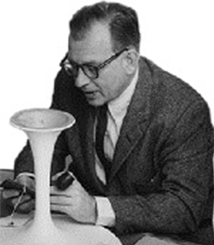
SAARINEEN
1910 – 1961
Eero Saarinen was born in Finland in 1910, the son of a famous Finnish architect and first President of the “Cranbrook Academy of Arts”.
He began his academic studies with important experiences in Paris at the La Grande Chaumière Academy from 1929 to 1930. This had a positive influence on his creativity and his enthusiasm for
the arts. He registered in a degree program at Yale University in Connecticut, graduating in 1934.
On his return to Europe he began to work in his father’s studio as well as teaching at the Cranbruk Academy. In 1941 the MOMA in New York launched a competition for the design of modern furniture, where the winner was an armchair designed by Saarinen in collaboration with Eames.
The theme of the competition was an organic design within a residential context. Thanks to the Knoll and Hermann Miller companies, extremely capable designers had the opportunity to have their designs produced
and exhibited to an international audience.
In 1948 Saarinen designed his first major work: a majestic arc on the banks of a river. As part of the work he carefully studied the location of the river and its surroundings so that the monument integrated perfectly with the surrounding environment. In 1953 he began to design furniture on stands, Saarinen’s solution for the problem of “shallow legs”, eliminating the relative visual confusion. He was not satisfied with this process, because he could
not produce this series from a single mould and a single material.
The base of the tables and chairs were made of an aluminum alloy, in the hope of someday finding a plastic material that was sufficiently resistant and that would bring out the beauty of the finished object.
His first great architectural project was the sensational TWA terminal in New York. Several of the elements that would characterize Saarinen’s work would appear in this work, showing the originality, diversity and unique nature of any single creation.
He died young in 1961.


